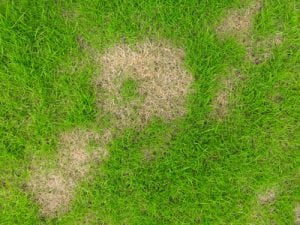
Turf Grass Diseases to Watch Out For: Protecting Your Lawn with Premier Landscape Management
Maintaining a lush, vibrant lawn is a priority for most homeowners, especially those who spend a great deal of time enjoying their outdoor spaces during the warmer months. Whether you’ve invested in aesthetic enhancements or practical upgrades, keeping your lawn healthy is essential. Premier Landscape Management, your go-to landscaping team in Boone, NC, offers comprehensive lawn care services. From regular maintenance and mowing to consultations for new landscaping features, hardscaping, and grading, we are equipped to handle all your lawn care needs. In this guide, we’ll delve into some common turfgrass diseases that affect both cool and warm-season grasses in our region, providing tips on how to identify, treat, and prevent them.
Understanding Turf Grass Diseases
Yellow Patch Disease
This disease primarily affects cool-season turfgrasses such as bluegrasses and common fescues, popular choices in the High Country. It typically manifests after prolonged periods with temperatures ranging between 50 and 65 degrees Fahrenheit, though it can occur outside these ranges. The most noticeable symptoms are circular rings, up to 3 feet in diameter, displaying yellow or white hues. Affected plants may show yellowing leaves or complete dieback. Although responsive to control measures, Yellow Patch Disease can be exacerbated by excessive nitrogen or nitrogen-producing elements.
White Patch Disease (White Blight)
Often confused with Yellow Patch, White Patch Disease, or White Blight, is a common ailment in transitional zones where tall fescue and bluegrass are predominant. This disease is particularly prevalent in conditions of high heat and humidity, making it a frequent concern during the peak summer months. The primary symptoms of White Patch Disease include distinctive white circular patches that can expand up to a foot in diameter, often accompanied by tiny white or tan mushrooms that emerge within these discolored areas.
White Patch Disease primarily targets under-irrigated tall fescue and grass that is deficient in nitrogen. The lack of adequate water and nitrogen weakens the grass, making it more susceptible to disease. However, with proper management, this condition responds well to treatments. Effective control measures include enhancing irrigation practices to ensure the grass receives adequate moisture and implementing a well-timed nitrogen fertilization schedule. These steps help to strengthen the grass, making it more resilient against the disease and aiding in the recovery of affected areas.
Furthermore, cultural practices such as proper mowing and avoiding the excessive application of nitrogen can prevent the conditions that foster White Patch Disease. It’s also crucial to ensure good air circulation around the affected areas; for instance, pruning nearby shrubbery or trees that may be contributing to poor airflow and excessive shade can mitigate the risk of disease. Regularly monitoring the lawn for early signs of the disease can lead to prompt treatment, which is often more effective and less invasive.
Powdery Mildew in Turf
Powdery Mildew presents a different challenge, predominantly impacting lawns in shaded areas where sunlight is minimal. This fungal disease is easily identifiable by a white or gray powdery substance on the leaves of the turf, which can quickly spread and cover large areas if left unchecked. The affected turf may exhibit leaves turning yellow or red, signaling distress, and without intervention, these areas may die.
The onset of Powdery Mildew is typically observed in the spring when the production and spread of spores commence. Managing this disease involves reducing shade and improving air circulation to discourage the growth of the fungus. Pruning overhanging branches and thinning out dense foliage can significantly increase sunlight penetration and air flow, creating less favorable conditions for Powdery Mildew.
Fungicidal treatments may also be necessary to control an existing infection. Choosing the right fungicide and applying it at the correct time are crucial steps that should ideally be performed under the guidance of lawn care professionals. Additionally, maintaining robust turf through proper fertilization, watering, and mowing practices can help prevent the establishment and spread of Powdery Mildew, keeping your lawn healthy and visually appealing.
Addressing Lawn Aesthetics and Health
Revitalizing Unkempt Lawns
If your lawn is unsightly, or if there’s a noticeable odor, Premier Landscape Management is here to help. We specialize in transforming unhealthy, weed-filled lawns into manageable and aesthetically pleasing landscapes. Our landscaping services in Boone, NC, are affordably priced, and we are dedicated to advising property owners on best practices and addressing any concerns.
Comprehensive Lawn Care Services
At Premier Landscape Management, we do more than just mow your lawn. We provide an array of services designed to enhance your outdoor living space. This includes constructing paved walkways, outdoor fireplaces, and retaining walls. We collaborate with construction teams on new home builds to tailor landscaping to homeowner preferences. Additionally, we offer essential winter services like snow removal in Boone, NC, to keep your property safe and accessible during the snowy months.
Connect with Premier Landscape Management
Ready to address your lawn care and maintenance needs? Contact Premier Landscape Management at 336-877-7990, or send us a message using our convenient contact form. We respond promptly to set up a consultation to discuss your specific lawn care challenges and objectives. We handle all the time-consuming and frustrating outdoor tasks, allowing you more time to enjoy your passions and time with loved ones.
Whether you are looking to recover a lawn affected by turfgrass diseases, enhance your property’s curb appeal, or need reliable maintenance services, Premier Landscape Management is here to ensure your lawn remains a point of pride and joy throughout the year.
